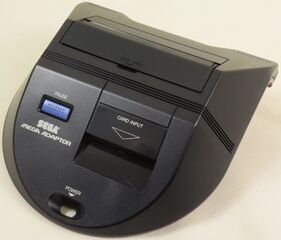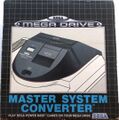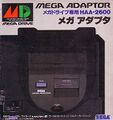Difference between revisions of "Power Base Converter"
From Sega Retro
| Line 1: | Line 1: | ||
{{AccessoryBob | {{AccessoryBob | ||
| accessoryimage=SegaMegaAdaptor.jpg | | accessoryimage=SegaMegaAdaptor.jpg | ||
| − | | imgwidth= | + | | imgwidth=300px |
| title=Power Base Converter/Mega Adaptor/Master System Converter | | title=Power Base Converter/Mega Adaptor/Master System Converter | ||
| maker=[[Sega]] | | maker=[[Sega]] | ||
| − | | | + | | madefor=[[Sega Mega Drive]] |
| usa=1989 | | usa=1989 | ||
| europe=1989 | | europe=1989 | ||
| Line 10: | Line 10: | ||
| rrp_jp=4,500 | | rrp_jp=4,500 | ||
}} | }} | ||
| − | The '''Power Base Converter''' ('''Mega Adaptor''' in Japan and '''Master System Converter''' in Europe), sometimes called the '''Master Deck''', was a Sega-vended accessory available at the [[Sega Mega Drive]]'s launch that allowed for the use of [[Sega Master System]] cards or cartridges with a Sega Mega Drive/Genesis | + | The '''Power Base Converter''' ('''Mega Adaptor''' in Japan and '''Master System Converter''' in Europe), sometimes called the '''Master Deck''', was a Sega-vended accessory available at the [[Sega Mega Drive]]'s launch that allowed for the use of [[Sega Master System]] cards or cartridges with a Sega Mega Drive/Genesis console. |
| − | + | One of the key design features of the Mega Drive is its compatibility with its immediate predecessor, the Master System, as the Mega Drive's design is based upon the Master System's design, albeit enhanced and extended in many areas. As the cartridge slot of the Mega Drive is shaped differently than that of the Master System, and because its games could not be played directly through the Mega Drive, Sega released the Power Base Converter, an accessory that is placed between a Master System cartridge and the Mega Drive, allowing the user to play the previous generation of Sega games without the need for an extra console. | |
| − | + | The Power Base Converter does not contain any Master System components but acts as a pass-through port. The converter contained 2 slots. The top slot was for cartridge based games. The front slot was for card based games and accessories. The Power Base Converter would be fully compatible with the cost-reduced Mega Drive II, were it not for the different shape of the Mega Drive II's casing. | |
| − | + | One can remove or modify the PBC casing, allowing it to work on a Mega Drive II. Instead, one must rely on the differently shaped '''Master System Converter II''', but unfortunately this accessory was only released in Europe. The Master System Converter II is also fully compatible with the original Mega Drive, but lacks the ability to run cards. | |
| − | There was at least one unauthorized third-party SMS adapter released for the Sega Mega Drive/Genesis—the no-frills Mega Master by [[Datel]]. It also | + | In order to achieve backwards compatibility, the original Master System central processor and sound chip (the [[Z80]] and [[SN76489]]) are included in the Mega Drive/Genesis and the new Video Display Processor is capable of the Master System VDP's mode 4 (though it cannot run in modes 0, 1, 2, or 3, so cannot run [[SG-1000]] games). Once a Master System game is inserted, the system's bus controller chip (later integrated with the I/O chip into a single multi-purpose ASIC) will put the Z80 in control leaving the [[68000]] idle. |
| + | |||
| + | Both 2-button Master System pads and standard Mega Drive pads can be used to play SMS games. Due to slight differences in how the Mega Drive pads operate, some Master System games may inadvertently cause the wrong set of inputs to be selected in a 3/6-button pad and prevent input from working properly. In this case a Master System controller must be used. Like the Master System, the PAUSE button is not part of the gamepad connector and instead is implemented as a pushbutton switch on the Power Base Converter or similar devices. | ||
| + | |||
| + | There was at least one unauthorized third-party SMS adapter released for the Sega Mega Drive/Genesis—the no-frills [[Mega Master]] by [[Datel]]. It also lacks a card slot, and has the SMS PAUSE button mounted on the side of the unit. | ||
== Gallery == | == Gallery == | ||
Revision as of 16:29, 10 January 2011

|
| Power Base Converter/Mega Adaptor/Master System Converter |
|---|
| Made for: Sega Mega Drive |
| Manufacturer: Sega |
The Power Base Converter (Mega Adaptor in Japan and Master System Converter in Europe), sometimes called the Master Deck, was a Sega-vended accessory available at the Sega Mega Drive's launch that allowed for the use of Sega Master System cards or cartridges with a Sega Mega Drive/Genesis console.
One of the key design features of the Mega Drive is its compatibility with its immediate predecessor, the Master System, as the Mega Drive's design is based upon the Master System's design, albeit enhanced and extended in many areas. As the cartridge slot of the Mega Drive is shaped differently than that of the Master System, and because its games could not be played directly through the Mega Drive, Sega released the Power Base Converter, an accessory that is placed between a Master System cartridge and the Mega Drive, allowing the user to play the previous generation of Sega games without the need for an extra console.
The Power Base Converter does not contain any Master System components but acts as a pass-through port. The converter contained 2 slots. The top slot was for cartridge based games. The front slot was for card based games and accessories. The Power Base Converter would be fully compatible with the cost-reduced Mega Drive II, were it not for the different shape of the Mega Drive II's casing.
One can remove or modify the PBC casing, allowing it to work on a Mega Drive II. Instead, one must rely on the differently shaped Master System Converter II, but unfortunately this accessory was only released in Europe. The Master System Converter II is also fully compatible with the original Mega Drive, but lacks the ability to run cards.
In order to achieve backwards compatibility, the original Master System central processor and sound chip (the Z80 and SN76489) are included in the Mega Drive/Genesis and the new Video Display Processor is capable of the Master System VDP's mode 4 (though it cannot run in modes 0, 1, 2, or 3, so cannot run SG-1000 games). Once a Master System game is inserted, the system's bus controller chip (later integrated with the I/O chip into a single multi-purpose ASIC) will put the Z80 in control leaving the 68000 idle.
Both 2-button Master System pads and standard Mega Drive pads can be used to play SMS games. Due to slight differences in how the Mega Drive pads operate, some Master System games may inadvertently cause the wrong set of inputs to be selected in a 3/6-button pad and prevent input from working properly. In this case a Master System controller must be used. Like the Master System, the PAUSE button is not part of the gamepad connector and instead is implemented as a pushbutton switch on the Power Base Converter or similar devices.
There was at least one unauthorized third-party SMS adapter released for the Sega Mega Drive/Genesis—the no-frills Mega Master by Datel. It also lacks a card slot, and has the SMS PAUSE button mounted on the side of the unit.
Gallery
US version
EU version
JP version






